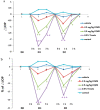Lowering the Intraocular Pressure in Rats and Rabbits by Cordyceps cicadae Extract and Its Active Compounds
- PMID: 35163975
- PMCID: PMC8837943
- DOI: 10.3390/molecules27030707
Lowering the Intraocular Pressure in Rats and Rabbits by Cordyceps cicadae Extract and Its Active Compounds
Abstract
Cordyceps cicadae (CC), an entomogenous fungus that has been reported to have therapeutic glaucoma, is a major cause of blindness worldwide and is characterized by progressive retinal ganglion cell (RGC) death, mostly due to elevated intraocular pressure (IOP). Here, an ethanolic extract of C. cicadae mycelium (CCME), a traditional medicinal mushroom, was studied for its potential in lowering IOP in rat and rabbit models. Data showed that CCME could significantly (60.5%) reduce the IOP induced by microbead occlusion after 56 days of oral administration. The apoptosis of retinal ganglion cells (RGCs) in rats decreased by 77.2%. CCME was also shown to lower the IOP of normal and dextrose-infusion-induced rabbits within 60 min after oral feeding. There were dose effects, and the effect was repeatable. The active ingredient, N6-(2-hydroxyethyl)-adenosine (HEA), was also shown to alleviate 29.6% IOP at 0.2 mg/kg body weight in this rabbit model. CCME was confirmed with only minor inhibition in the phosphorylated myosin light chain 2 (pMLC2) pathway.
Keywords: Cordyceps cicadae; N6-(2-hydroxyethyl)-adenosine (HEA); ganglion cells; intraocular pressure (IOP).
Conflict of interest statement
The authors declare no conflict of interest.
Figures








Similar articles
-
Intraocular pressure-lowering effect of Cordyceps cicadae mycelia extract in a glaucoma rat model.Int J Med Sci. 2021 Jan 1;18(4):1007-1014. doi: 10.7150/ijms.47912. eCollection 2021. Int J Med Sci. 2021. PMID: 33456358 Free PMC article.
-
Neuroprotective Effects of Cordyceps cicadae (Ascomycetes) Mycelium Extract in the Rat Model of Optic Nerve Crush.Int J Med Mushrooms. 2022;24(2):41-48. doi: 10.1615/IntJMedMushrooms.2021041522. Int J Med Mushrooms. 2022. PMID: 35446521
-
Safety Assessment of HEA-Enriched Cordyceps cicadae Mycelium: A Randomized Clinical Trial.J Am Coll Nutr. 2021 Feb;40(2):127-132. doi: 10.1080/07315724.2020.1743211. Epub 2020 Jul 23. J Am Coll Nutr. 2021. PMID: 32702252 Clinical Trial.
-
Long Non-Coding RNA-MALAT1 Mediates Retinal Ganglion Cell Apoptosis Through the PI3K/Akt Signaling Pathway in Rats with Glaucoma.Cell Physiol Biochem. 2017;43(5):2117-2132. doi: 10.1159/000484231. Epub 2017 Oct 24. Cell Physiol Biochem. 2017. Retraction in: Cell Physiol Biochem. 2021;55(3):383. doi: 10.33594/000000387. PMID: 29065394 Retracted.
-
Using submerged fermentation to fast increase N6-(2-hydroxyethyl)-adenosine, adenosine and polysaccharide productions of Cordyceps cicadae NTTU 868.AMB Express. 2019 Dec 9;9(1):198. doi: 10.1186/s13568-019-0892-4. AMB Express. 2019. PMID: 31820136 Free PMC article.
Cited by
-
Effect of ophthalmic preparation of methyldopa on induced ocular hypertension in rabbits.Naunyn Schmiedebergs Arch Pharmacol. 2025 Apr;398(4):4409-4417. doi: 10.1007/s00210-024-03570-1. Epub 2024 Oct 30. Naunyn Schmiedebergs Arch Pharmacol. 2025. PMID: 39476246
-
Current situation and progress of drugs for reducing intraocular pressure.Ther Adv Chronic Dis. 2022 Dec 2;13:20406223221140392. doi: 10.1177/20406223221140392. eCollection 2022. Ther Adv Chronic Dis. 2022. PMID: 36479139 Free PMC article. Review.
References
MeSH terms
Substances
Supplementary concepts
LinkOut - more resources
Full Text Sources

